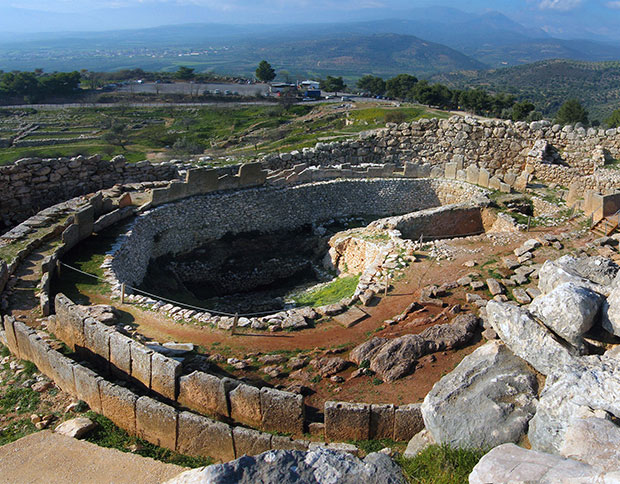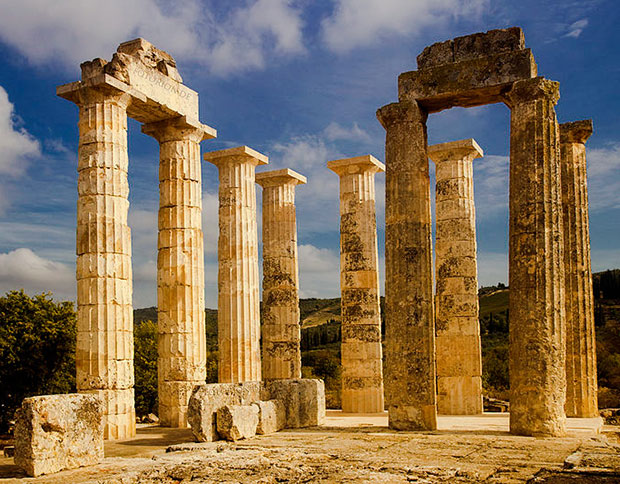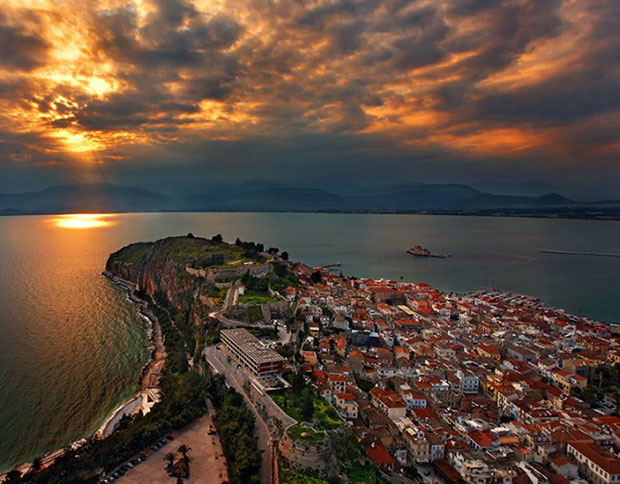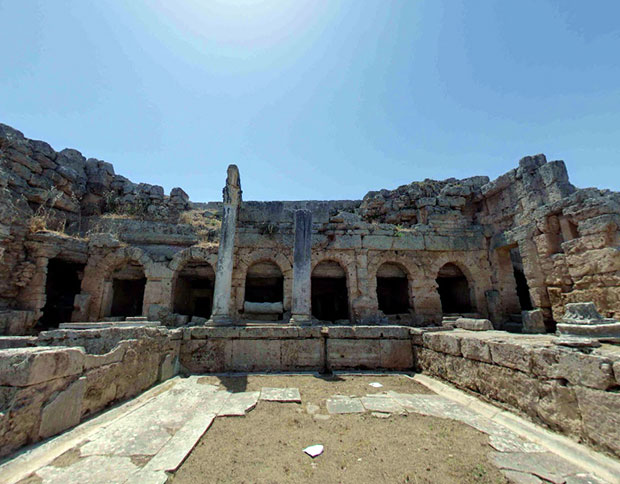Ancient Corinth - Ancient Mycenae - Ancient Nemea - Nafplio
Explore the Area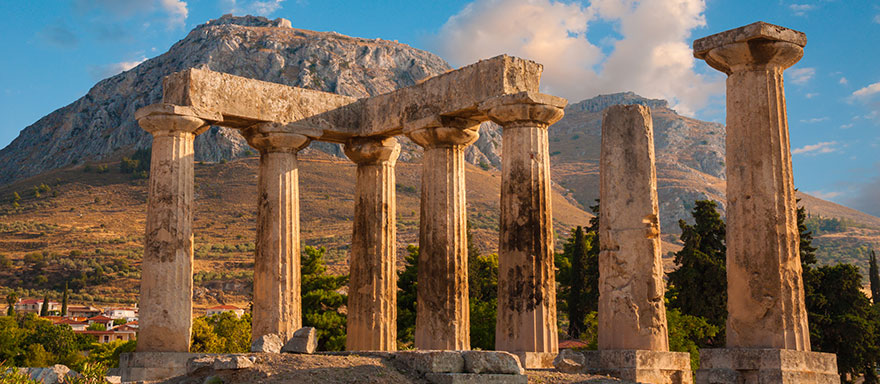
Ancient Mycenae
Ancient Mycenae is set amidst the Mountain of Agios Ilias and Mount Zara, approximately 22 km from Nafplion. For 400 hundred years this vestige of a kingdom was the most powerful in Greece, spreading between 1600-1200 BC.
Mentioned by Homer in the Odyssey and the Iliad the richness of Mycenae was thought only to be myth until archeologists literally struck gold in 1822-90. The citadel walls which are 13 metres high and 7 metres wide were thought, by the ancient Greeks, to have been built by a Cyclops.
See the famous Lion Gate entrance, royal graves where the famous gold death mask of Agamemnon was found, Agamemnon's palace and the great court. The whole site has a feeling of mystery, royal deaths, plots and greek tragedy. .
The Mycenean site also boasts a wonderful relatively new museum. Further along the road the Tomb of Agamemnon also know as the Treasury of Atreus is visible. A UNESCO World Heritage site, Mycenae is situated on a hill and is best visited early morning during the hot summer months.
Ancient Corinth
Ancient Corinth, was a city-state on the Corinthian Isthmus, a narrow piece of land that joins the Peloponnese with the Greek mainland. The ancient city of Corinth was founded in the 10th century B.C., it was one of the largest cities in Ancient Greece and the richest port of its time. This is also where Apostle Paul came to preach to the Corinthians and spread Christianity and later on founded a successful church. Corinth was also the place where he sent two of he's epistles, calling the Corinthians to stop their heathen and sinful way of life. The city was widely known throughout Greece for the wild life of it's residents.
Acrocorinth is located at a height of 574 metres above the city of Ancient Corinth and is well worth a visit.
The Isthmus is no longer part of the geographical characteristics of the area, in its place a canal has been opened, the Corinth Canal. It connects the Aegean and the Ionion Sea. The canals lenght is 6,4 kilometres and just 21,4 metres wide at its base, allthough there had been suggestions and attempts of creating the canal in ancient times the constuction started in 1881 and was complete 1893. Due to its narrow path it didn't attract the traffic expected and is now used as a tourist attraction.
Ancient Nemea
Ancient Nemea, like Olympia, was a Sanctuary where athletic games were held in honour of Zeus which were later known as the Panhellenic Festival Games.
In mythology, Nemea was famous as the home of the Nemean Lion, which was killed by the hero Heracles and as the place where the infant Opheltes, lying on a bed of parsley, was killed by a serpent while his nurse fetched water.
The Temple of Nemean Zeus (the god of shepherds and shepherding not the philanderer) was built around 330 BC and only three of the original columns remained. In 2002, two columns were reconstructed and in 2012 another four. The sanctuary of Zeus has had ongoing excavations since 1973: the great open-air altar, baths, and ancient accommodation for visitors can be seen. The temple stands on the site of an Archaic period temple, of which only a foundation wall is still visible.
The stadium has more recently been uncovered (in 1974) and was painstakingly excavated over a number of years. It is notable for its vaulted entrance tunnel complete with ancient graffiti on the walls, starting line and changing rooms. The revival of the Nemean Games has been a successful event for some years and it is possible to participate in the next (6th) Nemean Games. Registrations should be made before May 1, 2016.
In addition to its antiquities, Nemea is famous for its Agiorgitiko wine which is exported all over the world. There are many wineries, mostly family owned and operated, and many are open daily to the public for tasting and tours. Travel the "Wine Roads" of Nemea in a separate excursion or visit one of them for a tasting after your visit to the archaeological site.
Nafplion
Nafplion, once the capital of Greece in 1839, is also known by many other spellings and pronounciations: Nafplio, Nauplio, Nauplion, Nauplie, Nafpli, Anapli, Navplion.. the list is endless. Being voted as one of the prettiest towns in Greece makes Nafplion popular with Greeks and foreign tourists alike.
The old town of Nafplion is formed around the harbour and its graphic, narrow streets are full of curios and a mixture of architecture. Being occupied by the Venetians, Franks, Ottoman and Turls for hundrends of years the town has a little bit of each culture and this is reflected in the buildings.
Narrow Venetian style streets with overhanging balconies full of blossoming geraniums, romantic cafes and bars, typical Greek tavernas meet together with classical architecture, there is even a mosque (now used as a cinema). Syntagma Square is a bustling meeting place and giving the opportunity to sit in one of the many cafes and relax whilst people watching. Overlooking the whole of Nafplion, high on the hill, is the famous Palamidi Fortress, one of the three castles in the town and offers spectacular views. The Bourtzi castle in the harbour, rumoured to be the most photographes castle in Greece is accessible by water taxi and the Acronafplia castle lies at the foot of the Palamidi.
Fiercly proud of it's major part in the 1821 Battle of Independence, Nafplion has a choice of museums including the Archaeological museum, the Folklore museum, the Military museum, the Kompoloi (Worry Bead) museum and the unique Ouzo museum.
Time: approx. 11 hours
I have visited Mycenae during my European tour with friends. We were astonished by the grandeur and the craftmanship of people who built these walls and tombs. The museum was small, but the antiquities were well presented.
Visitor's review on Trip Advisor
Having visited the large sites at Epidavros and nearby Mycenae we had no high expectations of lesser known Nemea but we found it very evocative. The temple to Zeus and is interesting but do go into the museum. There are lots of artifacts of course but we found the little video on the starting mechanism for the races absolutely fascinating. It was then quite wonderful to enter the stadium through the tunnel and put ones toes on the original blocks used by the athletes over 2000 years ago. The site is beautiful with flowers everywhere!.
Visitor's review on Trip Advisor
